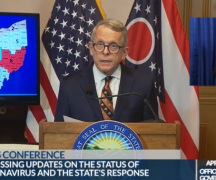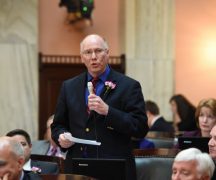A historic nuclear bailout scandal in Ohio has already led to six indictments — including that of a House speaker — three guilty pleas and, unfortunately, one death. Still more indictments are possible next month when a federal grand jury is expected to again take up the matter.
The whole sorry episode illustrates the desperate lengths some are willing to go to profit at public expense. It also shows the pernicious effect a rising form of political funding is having on government.
This is Sunshine Week, an annual event during which news organizations and other open-government advocates highlight the importance of making politics transparent to the public. While post-Watergate laws requiring open meetings and access to government records were meant to address the abuses of an earlier era, a new form of opacity — dark money — is fueling a new era of public corruption.
Last July, when then-U.S. Attorney David DeVillers announced the indictments of House Speaker Larry Householder and four associates, he also indicted a dark money group, Generation Now.
It was a 501(1)(4) “social welfare” organization that secretly pumped $61 million from energy interests into an effort to pass $1.3 billion in rate increases that would benefit those who contributed the money. Earlier this year, Generation Now pleaded guilty, in essence, to hiding the source of the millions that went to electing House members who voted to make Householder speaker, pass House Bill 6 and to thwart a citizen initiative to repeal the corrupt measure.
In announcing the indictments, DeVillers pointed to an essential ingredient of the criminal conspiracy.
“I don’t see how (the conspiracy) could possibly have happened,” he said, if not for the misuse of Generation Now which, unlike political action committees, doesn’t have to disclose its donors.
When the U.S. Supreme Court in 2010 issued its controversial decision in Citizens United v FEC, the majority argued that transparency would offset any harmful effects of allowing unlimited corporate money in politics. Disclosure of the sources of the money, Justice Anthony Kennedy wrote, would allow the public to “see whether elected officials are ‘in the pocket’ of so-called moneyed interests.”
But that’s not how things worked out.
The ensuing money blitz and lax IRS enforcement led to a proliferation of spending by groups whose entire purpose seems to be to influence politics and government while hiding the sources of the money. In an interview last month, DeVillers said the reason why is obvious.
“I don’t know why anyone would use (political-action committees) and super PACs that are regulated by the (Federal Election Commission) where your donors have to be disclosed,” he said. “With a dark money group you don’t have to, so why bother? Why even think about using a PAC or super PAC when you can use a 501(c)(4) where you don’t have to disclose who your donors are? It’s the perfect mechanism. If you don’t want to disclose your donors, there’s absolutely no reason why you’d use a PAC or super PAC.”
As powerful interests increasingly seek to operate behind the dark-money veil, the damage continues to mount.
There’s the Ohio energy-bailout scandal, which DeVillers said was “likely the largest bribery and money-laundering scheme ever in the state of Ohio.”
And dark money fueled scandals have infected other states.
In 2014, Utah was rocked when the public learned that the secret money Attorney General John Swallow used to drive a payday-lending critic from the state House came from… payday lenders.
Swallow attacked the lawmaker, Brad Daw, in the deeply Republican state by running ads falsely claiming that Daw supported Obamacare. But Swallow was forced to resign and voters re-elected Daw after they learned from a state investigation that it was all an effort by payday lenders to loosen state regulations over them.
Despite Justice Kennedy’s assurances, voters didn’t know who’s pocket Swallow was in and they only found out after a multi-million-dollar, taxpayer-funded investigation.
The Center for Responsive Politics, a campaign-finance watchdog, pointed to several other dark-money fueled scandals:
- In 2012, then Wisconsin Gov. Scott Walker faced a recall election after he ramrodded a union-busting law. Documents show that he persuaded wealthy conservatives to contribute piles of cash to dark-money groups to fund the anti-recall effort. This potentially violated state campaign-finance laws, but a Republican majority on the state supreme court threw out the case in 2015.
- Months after the Supreme Court issued its 2010 Citizens United ruling, two corporations contributed to a 501(c)(4) group in Montana that illegally coordinated with an effort to elect 15 Republican lawmakers who would back anti-union laws, a judge ruled. The case spanned more than a decade and resulted in a $1.76 million fine.
- In 2018, Missouri Gov. Eric Greitens resigned just 17 months into his first term in exchange for the dismissal of a computer-tampering charge. He also faced numerous allegations that he improperly used dark money groups to hide the sources of money for his political efforts, including to pass anti-union legislation. Greitens, who also was accused of sexual misconduct, is considering a run for the U.S. Senate seat being vacated by GOP Sen. Roy Blunt.
At the time the Supreme Court issued its ruling in Citizens United, critics predicted that it would only increase the corrupting influence of money in politics. And, as the examples above show, the ruling was not accompanied by the sunshine Justice Kennedy so blithely predicted.
But there are attempts at reform.
The For the People Act passed by the U.S. House of Representatives would require dark money groups to disclose all election-related expenditures above $10,000 and tighten rules against coordinating with campaigns. Similar legislation is pending in the Senate.
We’ll see if it passes and if it does, whether it fixes anything.
***
Also from Ohio Capital Journal:
Ohio bill would require hundreds of ballot drop boxes be installed across state
Democratic lawmakers want to increase voter drop box access throughout the state of Ohio, proposing to install hundreds of boxes for future elections.
State Reps. Bride Rose Sweeney, D-Cleveland, and Michele Lepore-Hagan, D-Youngstown, believe the additional drop boxes will make voting more convenient for Ohioans seeking to cast absentee ballots.
Secretary of State Frank LaRose, who oversees Ohio elections, restricted each county to having one drop box apiece during the 2020 General Election — and is directing the 88 county boards of elections to follow the same rule in the upcoming May election.
House Bill 209 would significantly increase the number of drop boxes installed in Ohio.
It would require that each incorporated community, township, census-designated place and college/university campus have a drop box. READ MORE
Limited testing clouds view of COVID-19 variants in Ohio
Public health officials are racing to vaccinate Americans against COVID-19 faster than new, more transmissible variants of the coronavirus can proliferate.
Limited visibility into how many of which variant is circulating in Ohio is clouding visibility into who’s winning the race.
The Ohio Department of Health sends either its first 17 coronavirus samples collected in a week, or 25 samples collected in a two-week period, directly into a CDC-contracted lab for genomic sequencing, according to a spokeswoman. From there, ODH’s in-house lab sequences about 100 samples per week.
Combined, it’s about 1% of the more than 11,000 average weekly infections in the state.
“One of the problems in the U.S. and other places is we haven’t had as good of genomic surveillance to tell us what the dynamics really are,” said Yonatan Grad, a professor of immunology and infectious disease at Harvard University’s T.H. Chan School of Public Health. READ MORE
Armed teacher proponents push continuing education over police training
Supporters of a bill that would allow teachers and other school personnel to carry guns in schools with concealed carry permits say the amount of training shouldn’t just be about the hours, but the consistency.
Sgt. David Spicer, of the Shelby County Sheriff’s Office, told the House Criminal Justice Committee the armed teacher program he uses in his county is a “CCW plus” program, teaching not only the basic concealed carry training but also building clearing tactics that law enforcement learns, and more range time than is required under Ohio law.
“It’s kind of unfortunate to say, but the teachers that are in our program shoot as well or better than the cops I train,” Spicer said.
Under House Bill 99, the minimum training needed to carry a firearm in schools would be that of a CCW license, which is eight hours. While Spicer said he supports the bill, he says there should be regular checkpoints for the training, not just checked boxes for a license. READ MORE





